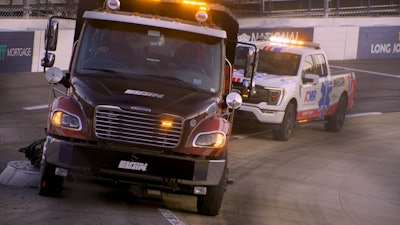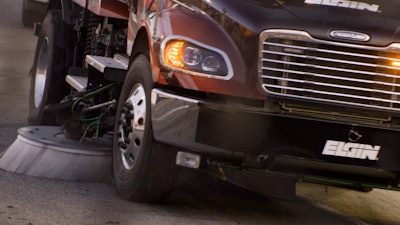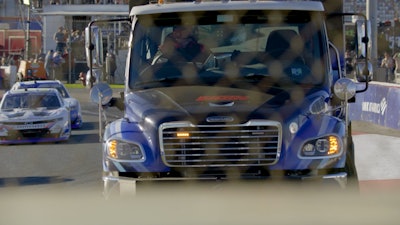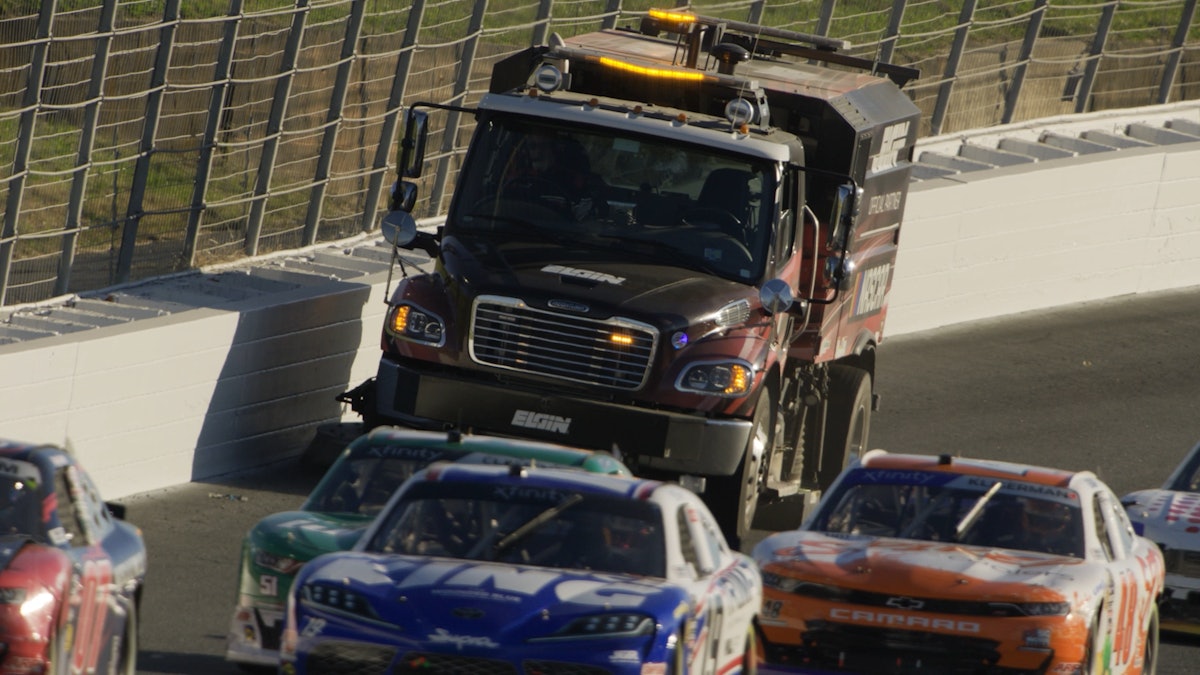Every year, more than 100,000 people attend the 36 official NASCAR races around the country. The popularity of the motor-sport has grown significantly over the last decade, and each individual race becomes a sort of multi-day event where fans congregate to, not just watch the race, but hang out, enjoy tail-gaiting, swap stories, and find new memorabilia of their favorite racing stars.
To the untrained eye, the track is just like any other road, but to those who spend their lives paving and maintaining asphalt, they know better. According to the Asphalt Institute, NASCAR tracks typically use PG 82-22 for the surface mix, which ensures a higher than normal softening point (typically 190 degrees) and friction. This prevents it from shifting or deforming under the extreme conditions of a NASCAR race.
The hot mix asphalt (HMA) is made up from a combination of a fine gradation of sand, stone, gravel, without larger aggregates with a thick layer of Polymer Modified Asphalt binder (PMA). The surface of the track can reach temperatures in excess of 160 degrees Farenhheit during a race, just from the friction caused by the more than three-thousand pound vehicles flying across it with their specialty tires.
These forces are extreme, as the cars stop, turn, or accelerate they push the asphalt to the limit in ways that normal cars never could. However, compared to the thicker spec used for highway building, which supports vertical loads like a heavy semi truck, these race tracks are made to withstand greater lateral forces.1
The design of a track is part of the overall safety plan for the drivers, because a surface failure could spell disaster when traveling at those speeds. Sadly, despite any and all efforts to prevent them, accidents happen between racers almost every time they take the track. When they do happen, it’s important to the safety of the remaining racers that the track is cleared of any and all debris as quickly and thoroughly as possible.
To achieve this, they employ a pair of specially designed street sweepers designed by Elgin.
The Coolest Sweeper Operator You’ve Never Heard Of
Wally Hayes is the liaison to track and NASCAR operations, working for Champion Tire and Wheel, and it’s his job to make sure the sweepers are transported to each race and in fully working order when they’re called into action.
“Elgin has been involved with NASCAR for quite some time now, ten plus years,” Hayes told me. “This season will be our third season since our group took over operating the sweepers for them.”
While he makes sure that the sweepers make it safely from track-to-track, Hayes didn’t come from a background in contract sweeping. His background was in transportation and logistics, including large hauling of oversized loads across the country. He joined Champion Tire and Wheel about a decade ago.  Provided by Elgin Sweepers Company
Provided by Elgin Sweepers Company
“We haul as a company, moving a team’s pit boxes and other things,” he said. “We don’t haul the actual cars, but almost everything else that a team needs with them on the track.”
Previously, local sweeping contractors were enlisted to help operate the sweepers for NASCAR, but over time that changed. Like a lot of contract sweeping companies (and everyone else for that matter) it became harder to find qualified operators in every stop. That partially led to Wally’s team taking over the responsibility. Elgin sent out a representative to train Hayes and some of his team, and they’ve been running things ever since.
The Responsibilities Of A NASCAR Sweeper
Hayes and the sweeper team usually arrive at the new track before anyone else from the circuit gets there. It’s their first responsibility to make sure that everything is good to go, ready for when the circus arrives.
“That first day we have cars on the track is when it gets busy,” Hayes said. “That’s when we do what they call ‘track prep,’ and we’ll send our guys to blow [off the surface], then the Elgin’s come by and run the walls. They’re picking up everything from small particles, rubber, nuts, bolts, and whatever else might be out there.”
The remnants of previous races and collisions isn’t the only thing they use the sweepers for ahead of a new race. Sometimes the weather isn’t ideal, especially if it dumps a bunch of rain over the track.
“When it comes down to rain, we have to do a lot of vacuuming, then dumping it out, and repeat that process until the track is dry enough,” he explained.
Hayes further detailed that the rain issue can be the biggest headache for the sweepers to deal with, especially if they’re having to make twenty or thirty trips from the track to a dump spot for the excess water they collect. A lot of times, they don’t have a nearby area to dump it, and they have to drive completely out of the course arena to dispose of it.  Provided by Elgin Sweepers Company
Provided by Elgin Sweepers Company
Other times they might sweep up something they aren’t supposed to, and finding it can be a bit of a time consuming problem.
“We’ve swept up all kinds of things, but sometimes [after an accident] we might sweep up the NASCAR transponders which they use for the cars. Once they get inside the hopper, they can’t see it any longer. So, we’ve walked and walked the track before looking for them everywhere before, finally, dumping out the hopper to see if it’s there. You end up having to dig through a bunch of rubber and dirt, but it’s usually all the way at the bottom.”
Sweepers In The Race
The pre-race preparations and storm water removal is all done on an empty track, but the most exciting and interesting sweeping happens when, during the middle of a race, the sweepers have to join the cars on the track itself.
“They keep the cars moving, just not a race speed,” Hayes said. “If it’s a [big] mess they might throw a red flag and stop the cars. Then we sweep from the top of the wall, downwards. If it’s an oil-down, which is what it ends up being most of the time, they’ll lay out speedy dry to soak it up first. Then we will follow behind with these big stiff brooms on our machines.”
Even with modern cameras that can put spectators inside the cars themselves, Hayes says that nothing does full justice to what it’s like to be out on the track alongside the cars themselves.
“If I do go out [in the sweeper] during the race, it’s pretty unique,” he said. “Obviously, you’re not moving anywhere even near what they do, but you’ve got the cars weaving in and around you, and you’re going even slower than when you do track prep. We have our safety lights flashing, strobes, and a NASCAR safety vehicle is usually behind us called a chase truck. When the cars are swerving, they can get pretty close, come across the nose of the sweeper. When it gets tight like that, there’s nothing else like it, pretty exciting even at slow speeds.”
The track crew uses safety spotters to help direct the drivers, alerting them to where the sweepers are on the course, but they also can communicate to the sweeping team about where they are needed. Provided by Elgin Sweepers Company
Provided by Elgin Sweepers Company
Not Your Average Sweepers
Just like NASCAR has a specially designed asphalt spec for the track itself because of their extreme needs, they also had special requirements for the sweeper. To meet these challenges, Elgin created the Crosswind Specialty Track Sweeper.
“[It] differs significantly from standard street sweepers due to its specialized features tailored for racetrack maintenance,” said Noah Baran, Elgin Product Manager.
According to Elgin, here are some of the things that set the Crosswind apart from its off-the-shelf counterparts:
- Sweeper Functions: Engineered specifically for use on steep-banked racetracks.
- Pickup Head: Designed specifically for high-speed track cleaning, ensuring optimal debris removal.
- Side Air Blast: Uses a powerful side air blast to dislodge debris from the track surface efficiently.
- Poly Side Broom Bristles: Equipped with durable poly side broom bristles that effectively sweep without causing track damage.
- Object Detection Systems for Blind Spots: Integrated object detection technology enhances safety by identifying potential obstacles in blind spots.
- Camera Systems for Visibility: Advanced camera systems provide operators with enhanced visibility around the truck, improving maneuverability and safety.
But how do these features address the specific needs of NASCAR? And in what ways do those needs diverge from the standard needs of a commercial parking lot or municipal client?
Jeff Peters, Manager of Technical Services and Support at Elgin, explained in greater detail:
“The specialized modifications of the NASCAR sweepers are designed to ensure a clean, dry, and safe racing environment, directly addressing NASCAR’s need for optimal track conditions,” The Elgin Crosswind Specialty Track Sweeper is specifically engineered for steep-banked racetracks, making it ideal for both routine maintenance and emergency response cleaning.
Its advanced features, including high-speed debris removal, oil absorbent material collection, and efficient drying capabilities, enhance track safety during races. By integrating powerful suction, side air blast technology, and precision sweeping, this machine plays a critical role in maintaining ideal racing conditions, reducing the risk of accidents, and allowing for uninterrupted competition.”
In the various echelons of pavement maintenance, those who keep and maintain the high-end surfaces of a major motor speedway might be a specialized group and few in number. However, the work they do is essential for safety and preservation, and that is no different than the work that all sweeper operators do day-in and day-out.
View the original article and our Inspiration here


Leave a Reply